Operation of police powers under the Terrorism Act 2000 and subsequent legislation: Arrests, outcomes and stops and searches, quarterly update to 31 December 2014
Published 25 June 2015
Consultation
The Home Office would like to get a better understanding of who uses these statistics, and the ways in which they use them. For this reason, the Home Office is conducting a consultation on these statistics to seek feedback on some potential changes. This is with a view to ensuring that they meet user needs as closely as possible in future.
Further details can be found in the consultation section at the end of this release. The Home Office invites all users of the statistics to respond.
1. Introduction
This release covers the use of police powers under terrorism and terrorism-related legislation in Great Britain in the most recent 9 quarters to 31 December 2014. The release is broken into 4 sections.
The ‘arrests and outcomes’ section uses data provided by the ACPO Counter Terrorism Coordination Centre (ACTCC) and includes statistics for Great Britain on:
- arrests for terrorism-related activity, and outcomes (such as charges and convictions) following arrests
- the legislation used to bring charges and convictions
- gender, age, ethnicity, and nationality of those arrested, charged and convicted
- the type of terrorism involvement of those arrested, charged and convicted (such as whether the individual had links to international, domestic, or Northern-Ireland-related terrorism) A flow chart summarising this section can be found in Annex A.
The ‘court proceedings’ section uses data from the Crown Prosecution Service (CPS) and includes statistics for England and Wales on:
- the number of persons proceeded against by the CPS for terrorism-related activity
- the legislation under which persons have been prosecuted and convicted
- the sentence length given to those convicted for terrorism-related offences
The ‘terrorist and extremist prisoners’ section uses data from the National Offender Management Service (NOMS) and the Scottish Prison Service (SPS) and includes statistics for Great Britain on:
- the number of persons in custody for domestic extremism and terrorism-related offences
- the ethnicity, nationality and religion of those in custody
- the number of persons released from custody
The ‘stop and search’ section uses data provided by the Metropolitan Police Service (MPS) and the National Counter Terrorism Policing Headquarters (NCTPHQ) and includes statistics on:
- the number of stops and searches carried out by the MPS under section 43 of the Terrorism Act (TACT) 2000
- the number of examinations and subsequent detentions made in Great Britain under Schedule 7 to TACT 2000
Further details on this release, including a summary of the criminal justice process, details of the terrorism legislation covered and definitions of the different categories of terrorists can be found in the user guide. A flow chart summarising the ‘arrests and outcomes’ section of this release can be found in Annex A. Data tables also accompany this release.
1.1 Uses of the data
Data presented in this release are used to monitor the way in which legislation is used to tackle terrorism in the UK. It enables the level of police activity to be tracked over time, as well as changes in the demographics and types of terrorist being targeted by anti-terrorism powers. The release is used to answer requests for information on terrorism-related offending in Great Britain, and to brief Ministers on the range of terrorism-related activities highlighted in this release.
2. Key findings
2.1 Arrests and outcomes
In the year ending 31 December 2014:
- There were 289 arrests for terrorism-related offences, an increase of 30% compared with the previous year. This was driven mainly by an increase in arrests in the most recent quarter (October to December 2014).
- The increase in the number of arrests was driven by:
- a large increase in the number of 18- to 20-year-olds being arrested, which more than tripled from 15 to 46
- a 48% increase in the number of persons arrested for international-related terrorism
- Of those arrested for terrorism-related offences and subsequently charged, the proportion who were charged with terrorism-related offences was 86%, up from 56% in the previous year.
2.2 Court proceedings
In the year ending 31 December 2014, there were 38 persons proceeded against for terrorism-related offences (down from 44 in the previous year). Of these, 31 were convicted, 20 of whom entered a guilty plea.
2.3 Terrorist and extremist prisoners
As at 31 December 2014, there were 183 persons in custody for terrorism-related offences and domestic extremism. This was an increase of 36 prisoners compared with the same time last year (as at 31 December 2013), and an increase of 38 compared with the number of persons in custody at the end of the previous quarter (30 September 2014).
2.4 Stops and searches
In the year ending 31 December 2014:
- The MPS carried out 394 stops and searches under section 43 of TACT 2000. This was a reduction of 20% compared with the previous year. Falls were seen for all ethnic groups, but the number of people searched who considered themselves to be ‘Asian or Asian British’ saw the largest fall, down 45% compared with the previous year.
- The proportion of persons searched who were subsequently arrested was 6%, down one percentage point compared with the previous year.
- The number of examinations under Schedule 7 to TACT 2000 fell by 24% from around 46,000 to 35,000. Across the same period, the number of resultant detentions almost doubled from around 550 to 1,000.
3. Arrests and outcomes
Statistics presented in this section represent the number of persons arrested by police in Great Britain, where there is suspicion of involvement in terrorist activity, either at the time of arrest, or at a subsequent point in the investigation. In some cases after a terrorism-related arrest, evidence may emerge that suggests a suspect does not have links to terrorism, but has committed an offence. These cases are included in the arrest data as non-terrorism-related charges and/or convictions. Outcomes following these arrests are also included in the statistics and show the number of arrests that led to a charge or prosecution, as well as other outcomes. All data in this section are based on the date of arrest. This allows users to see the outcomes of all of the arrests in a specific period, i.e. how many led to a charge and conviction.
Data are provided to the Home Office by ACTCC and are taken from a live database. The data cover the most recent 9 quarters up to 31 December 2014 and are correct at the time of data provision (2 April 2015).
A flow chart summarising this section can is included in Annex A. This follows individuals from the point of arrest through to charge (or other outcome), and prosecution.
3.1 Arrests
In the year ending 31 December 2014, there were 289 persons arrested for terrorism-related offences. This was a 30% increase on the previous year. The increase was driven by a relatively large number of arrests in the most recent quarter (October to December 2014), in which there were 106 arrests, more than double the number in the same quarter in 2013.
In the most recent year, the proportion of arrests under section 41 of TACT 2000 has shown an increase compared with the proportion under other legislation. In the year ending 31 December 2014, 22% of arrests were under section 41 of TACT 2000, up 4 percentage points on the previous year.
Since 11 September 2001, 60% of all terrorism-related arrests have been under section 41 of TACT 2000. Although the use of this arrest power has seen a recent increase, it is still used in a lower proportion of cases than it has been since 11 September 2001.
Figure 2.1 Arrests for terrorism-related offences, by type of legislation
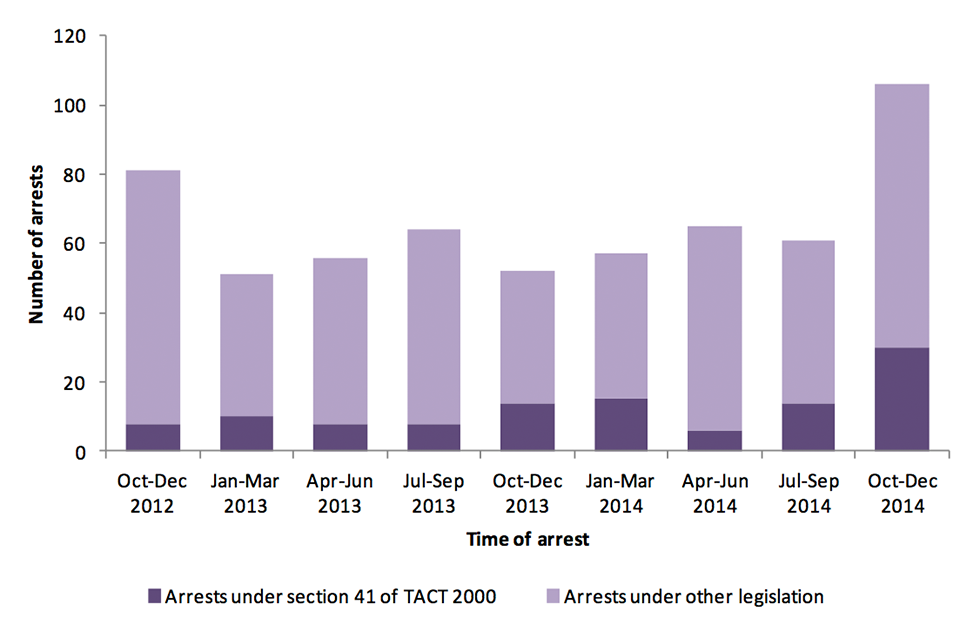
Source: Home Office, Data table A.01.
The number of persons released without charge following a terrorism-related arrest accounted for 38% of all those arrested in the year ending 31 December 2014, up 3 percentage points on the previous year. This number could increase as more cases reach completion.
3.2 Pre-charge detentions under section 41 of the Terrorism Act 2000
Once a suspect has been arrested by the police, they may be held for a specified period of time before being charged. This gives police the time to investigate and accumulate evidence pertaining to potential terrorism offences. The current maximum period of detention under section 41 of TACT 2000 is 14 days (reduced from 28 days on 25 January 2011), compared with a maximum of 4 days under standard arrest powers. Further details of the legislation can be found in the user guide.
In the year ending 31 December 2014, 65 persons were detained under section 41 TACT. Of these, 35 were charged and 30 were subsequently released.
Figure 2.2 Detention times of persons arrested under section 41 of the Terrorism Act 2000, by outcome, year ending 31 December 20141,2
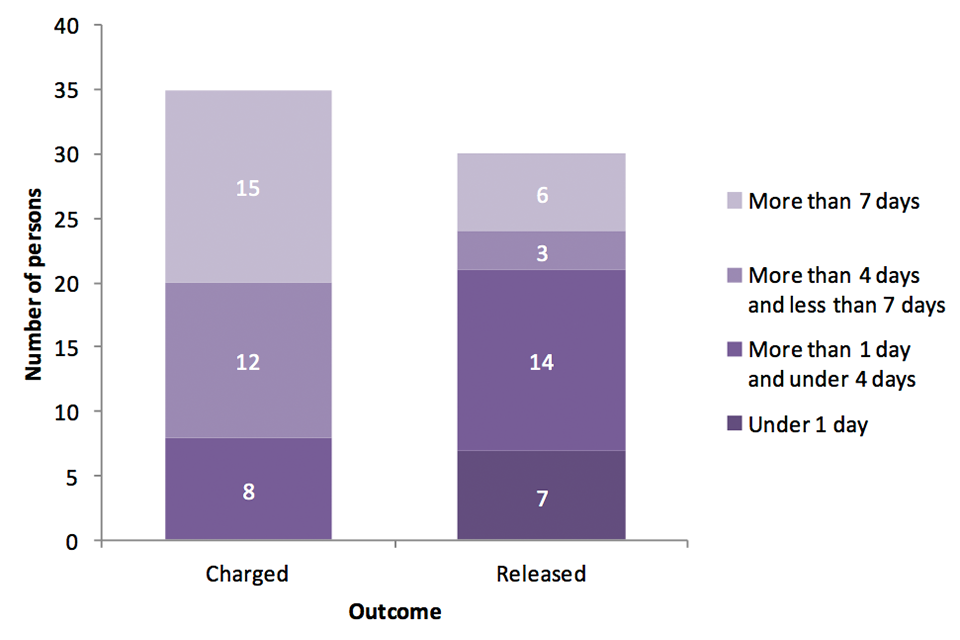
Source: Home Office, Data table A.02.
Chart Notes:
- Based on date of arrest.
- There were no charges following a detention period of under 1 day.
3.3 Charges
Once the maximum pre-charge detention period has been reached, the police must charge a suspect, release the suspect without charge, release the suspect on bail, or take alternative action such as issuing a caution.
Of the 289 arrestees in the year ending 31 December 2014, 111 were charged with an offence. Of these offences, 96 (or 86%) were considered to be terrorism related. This is an increase on the 56% which were considered terrorism related in the previous year, suggesting that police were more frequently able to find evidence to support the link to terrorism following a terrorism-related arrest.
Figure 2.3 Persons charged following terrorism-related arrests, by type of charge
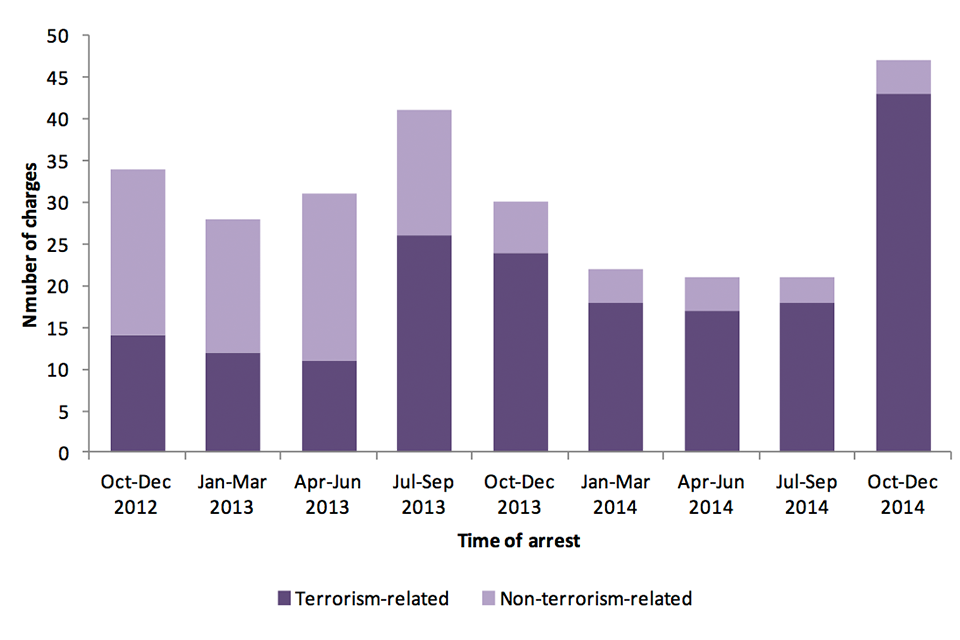
Source: Home Office, Data table A.04.
Of the 289 persons arrested in the year ending 31 December 2014, 111 were charged and 110 were released without charge. A further 57 were bailed to return pending further investigation and 11 faced alternative action (such as receiving a caution, or being detained under an international arrest warrant).
As police investigations progress, cases involving those bailed pending further investigation will become finalised. This will lead to the number of charges and other outcomes increasing over time. More recent time periods are likely to have a greater number of non-finalised cases. This is shown in Figure 2.4, where a greater proportion of cases in more recent quarters are ‘bailed to return’. This should be taken into consideration when comparing figures over time.
Since 11 September 2001, when the data collection began, 39% of those arrested for terrorism-related offences have been charged. More recently, police have charged suspects in a higher proportion of cases, with a charge rate of 58% in the year ending 31 December 2013. The year ending 31 December 2014 has seen a 38% charge rate, although this is expected to increase as more investigations are completed.
Figure 2.4 Proportional breakdown of outcomes, up to point of charge, following arrests for terrorism-related offences

Source: Home Office, Data table A.03.
3.4 Charges by offence
In line with the normal procedures for criminal justice statistics, each suspect has been classified in terms of a single principal offence. This means that when an individual is charged with a number of offences, they are recorded only against the most serious one, usually the one that carries the highest penalty. This means that the figures count the number of individuals charged, rather than the number of individual offences committed that led to a charge.
The most common offence for which persons have been charged with under terrorism legislation since 11 September 2001 is ‘preparation for terrorist acts’ (section 5 of TACT 2006), which has accounted for 14% of all terrorism-related charges since then, and 31% in the year ending 31 December 2014.
Further details of the legislation under which persons have been charged following a terrorism-related arrest can be found in tables A.05a-c.
3.5 Court proceedings and outcomes of charges
Once an individual has been charged they are likely to face prosecution. If an individual has been charged with a terrorism-related offence, they may still be convicted of a non-terrorism-related offence, for example in cases where there is insufficient evidence to link an offence to terrorism but another non-terrorism-related offence has been committed.
The statistics presented here are based on arrest dates. If an individual is prosecuted in a particular quarter, the prosecution will show against the quarter in which the individual was initially arrested. Due to the complex nature of terrorism investigations, trials may take place several years after an arrest or charge occurs. As time goes on, more trials will reach conclusions, so figures for previous quarters may be updated. For this reason, caution must be taken when comparing prosecution rates over time. More recent years/quarters are likely to have lower prosecution rates as more cases are awaiting completion.
Figure 2.5 Outcomes following charges for terrorism-related offences, year ending 31 December 20141.
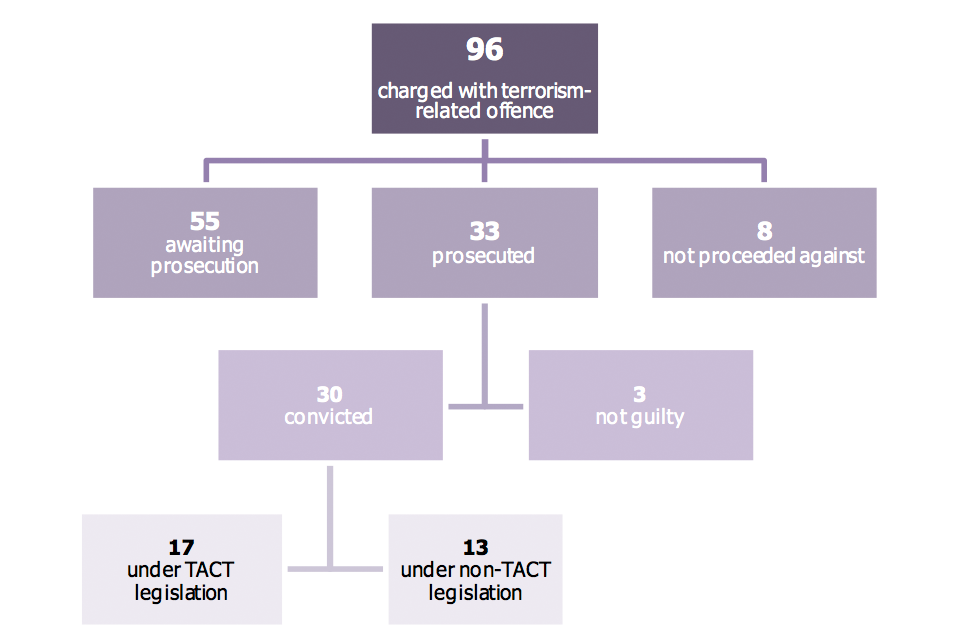
Source: Home Office, Data table A.06c.
Chart Notes:
- Based on date of arrest.
- A more detailed flow chart can be found in Annex A.
3.6 Convictions by offence
The most common offence for which persons have been convicted for terrorism-related offences since 11 September 2001 is ‘preparation for terrorist acts’ (section 5 of TACT 2006), which has accounted for 15% of all terrorism-related convictions. This offence was also the most common offence for which persons were charged.
Further details of the legislation under which persons have been convicted following a terrorism-related arrest can be found in tables A.06a-c.
3.7 Gender, age and ethnic appearance of persons arrested, charged and convicted
Since 11 September 2001, 92% of terrorism-related arrests have been of males. In more recent quarters this has dropped slightly averaging 90% in the most recent 9 quarters.
The number of 18- to 20-year-olds arrested for terrorism-related offences saw the largest increase of all age groups (from 15 to 46) in the year ending 31 December 2014 compared with the previous year. There was also a marked increase in the number of arrestees aged 21–24, and 30 and over.
Figure 2.6 Number of terrorism-related arrests, by age group1, year ending 31 December 2014 compared with the year ending 31 December 2013
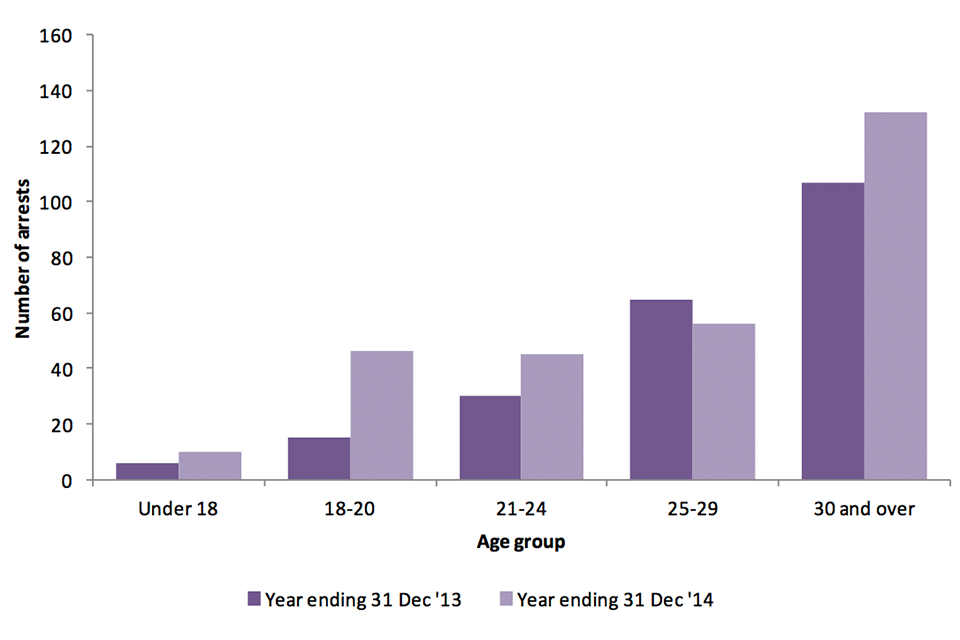
Source: Home Office, Data table A.10.
Chart Notes:
- Excludes cases where age was not known.
The number of persons arrested for terrorism-related offences who were of ‘Asian’ ethnic appearance saw a 51% increase in the year ending 31 December 2014 compared with the previous year, leading this group to account for nearly half of all terrorism-related arrests. Although the arrests of those who were of ‘White’ and ‘Other’ ethnic appearance also saw an increase, these were relatively small in comparison.
Figure 2.7 Number of terrorism-related arrests, by ethnic appearance1, year ending 31 December 2014 compared with the year ending 31 December 2013
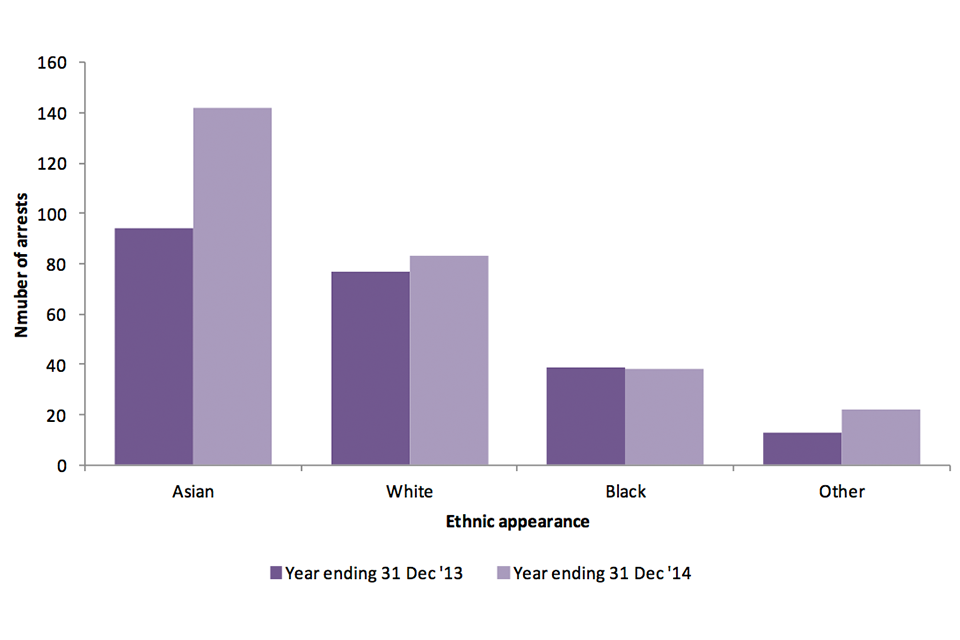
Source: Home Office, Data table A.11.
Chart Notes:
- Excludes cases where ethnic appearance was not known.
3.8 Nationality of persons arrested, charged and convicted
In the year ending 31 December 2014, 76% of those arrested for terrorism-related offences considered themselves to be British, up 6 percentage points from 70% in the previous year. Since 11 September 2001, 53% of those arrested for terrorism-related offences considered themselves to be British suggesting that a growing number of people arrested for terrorism are British. The nationalities of those charged for terrorism-related offences and convicted following such a charge were proportionally similar to those arrested for terrorism-related offences.
Further details on the nationalities of those arrested for terrorism-related offences, charged for terrorism-related offences, and convicted following a charge for terrorism-related offences can be found in tables A.12a-c.
3.9 Categorisation of persons arrested, charged and convicted
Statistics on the categorisation of those arrested, charged and convicted are summarised below. Categorisations are based on whether an individual is found to have involvement with any type of terrorism, either at the time of arrest or following subsequent investigations. The categories identify those associated with: * international-related terrorism – activities linked to or motivated by any terrorist group based outside the UK * Northern-Ireland-related terrorism – activities supporting the actions or ideology of proscribed Northern-Ireland-related terrorist groups * domestic terrorism – terrorism-related activity where there are no links to Northern Ireland or international terrorism * not classified – persons thought to be associated with any type of terrorism at the time of arrest or charge (which could include airport travellers charged for failing to comply with an examination under Schedule 7 to TACT 2000), then found to have no terrorist links after investigation
For more information on the categorisation of terrorism-related suspects see the user guide.
The number of persons arrested for international-related terrorism increased by 48% in the year ending 31 December 2014, compared with the previous year. Domestic terrorism also saw a slight increase (from 17 to 28), but the majority of the increase can be accounted for by arrests for international-related terrorism.
The number of people charged with international-related terrorism also saw a year-on-year increase from 42 in the year ending 31 December 2013 to 72 the following year.
3.10 Data tables
Statistics on persons arrested for terrorism-related offences, and the resulting charges and outcomes, can be found in tables A.01 to A.13. These include data on types of arrests, charges and prosecutions, the legislation and powers police have used to deal with terror suspects, and demographic breakdowns of individuals arrested, charged and prosecuted.
3.11 Data quality and interpreting the figures
Statistics presented in this section are provided to the Home Office by ACTCC and are correct at the time of data provision (2 April 2015). As cases progress over time, outcomes can change and figures for previous quarters may be updated in this release. ACTCC regularly review their cases to ensure records are up to date. This can result in records being added, removed or amended.
As there are a relatively small number of persons arrested for terrorism-related offences each year, the data are subject to proportionally large fluctuations. Changes in police and public activity and attitudes can have an impact on the number of persons arrested. For example, terrorism-related events (such as the London attacks on 7 July 2005) can impact upon public reporting of suspicious activity, and in turn, arrest patterns. Furthermore, police operational decisions in response to specific threats or events (such as the London 2012 Olympics) can have an impact. Individual cases involving multiple suspects can also affect the figures.
Ethnicities of persons arrested that are presented in this section are based on ethnic appearances recorded by the police at the time of arrest. In some cases, this may differ from the actual ethnicities of persons arrested. Self-declared nationalities of persons arrested may also differ from their actual nationalities, if for example, the arrestee gives a false nationality at the time of arrest.
Categorisations of those arrested for terrorism-related offences are based on assessment from ACTCC and may not be mutually exclusive. Additionally, categorisations may change as cases progress and new evidence comes to light. From the year ending March 2011 onwards, the use of the ‘not classified’ category was reviewed to ensure that stricter categories of involvement were adhered to. As a result, figures from that year onwards include a greater number of ‘not classified’ persons, and are therefore not directly comparable to previous years’ figures.
The user guide provides further details relating to definitions, legislation and procedures, and data quality.
4. Court proceedings
This section presents statistics on prosecutions for terrorism-related offences in England and Wales. It provides data on the number of persons prosecuted and convicted, including information on the legislation against which they were prosecuted. It also provides information on the length of sentence that each defendant faces. Data in this section are based on the date of trial completion.
Data are provided to the Home Office by the Crown Prosecution Service Counter Terrorism Division (CPS CTD). The data cover terrorism-related court cases that were completed in the most recent 9 quarters up to the 31 December 2014.
4.1 Court proceedings
In the year ending 31 December 2014, there were 38 trials completed by the CPS CTD for terrorism-related offences. In 31 of these cases, the defendant was convicted. In the remaining 7 cases, the defendant was acquitted.
The principal offence for which these defendants were tried against came under a range of both terrorism-related (TACT) legislation and non-terrorism-related (non-TACT) legislation. Details of the specific offences for which individuals have been prosecuted and convicted against can be found in tables C.02 and C.03.
Figure 3.1 Outcome of terrorism-related trials under TACT and non-TACT legislation1, year ending 31 December 2013 and year ending 31 December 2014
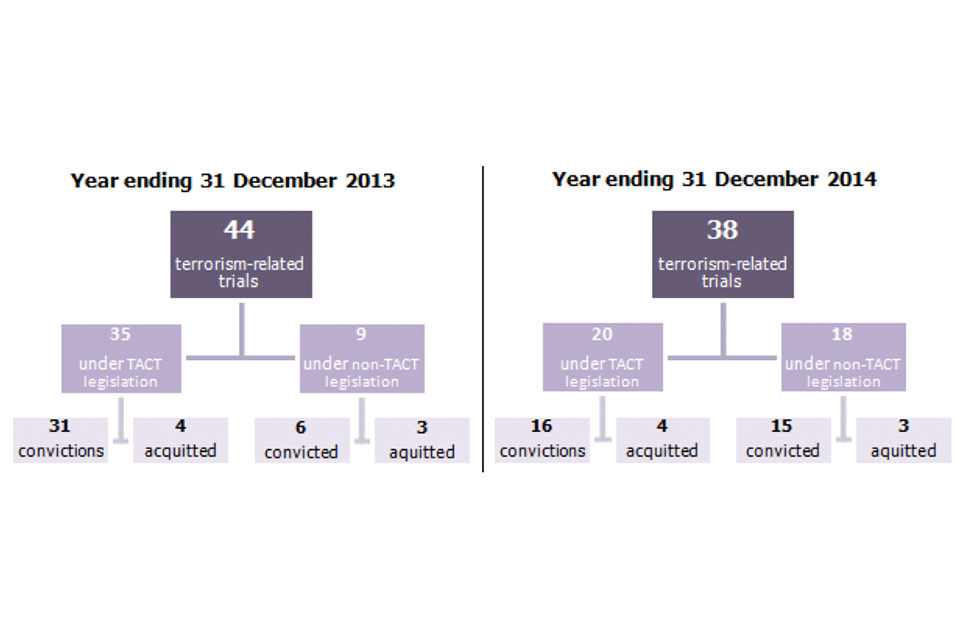
Source: Home Office, Data tables C.01-C.03.
Chart Notes:
- Based on the principal offence for which the defendant was prosecuted against.
4.2 Sentencing
A total of 31 persons were convicted of terrorism-related offences in the year ending 31 December 2014. Of these, 20 pleaded guilty and 11 entered a not guilty plea.
Figure 3.2 Sentence length for persons convicted of terrorism-related offences, year ending 31 December 20141,2

Source: Home Office, Data tables C.04.
Chart Notes:
- Based on the trial completion date.
- The ‘other’ category includes hospital orders and non-custodial sentences.
Further breakdowns of sentences for those convicted of terrorism-related offences, including breakdowns of those convicted for TACT and non-TACT offences can be found in table C.04.
4.3 Data tables
Data to accompany this section can be found in tables C.01 to C.04.
4.4 Data quality and interpreting the figures
In line with the normal procedures for criminal justice statistics, and in order to present data on the number of persons dealt with by CPS CTD (rather than the number of individual offences), data in this section are presented on a principal offence basis. This means that if an individual is proceeded against for multiple offences at the same time, the most serious offence is the one counted in these data. If an individual is subsequently proceeded against on another occasion for a different offence, the additional case will also be included in the dataset.
Due to the complex nature of terrorism investigations, court proceedings may take place several years after an arrest or charge takes place. Trials completed in a particular time period may relate to arrests that have taken place at an earlier period. For example, a person sentenced in the year ending 31 December 2014 may have been arrested in the year ending 31 December 2013. Statistics presented here are based on the trial completion data and are not directly comparable to the court proceedings data in section 3 (arrests and outcomes). Data in section 3 are based on the time of arrest.
5. Terrorist and extremist prisoners
Statistics presented in this section give information on the number of persons in custody for terrorism-related offences and domestic extremism in Great Britain. It includes breakdowns of the ethnicity, nationality and religion of prisoners at a given time. Data on the number of terrorist/extremist prisoners released from custody are also available in this section.
Data are provided to the Home Office by NOMS and the SPS. The data give information about the prison population at the end of each of the last 9 financial quarters to 31 December 2014. Data on the number of prisoners released in each of the last 9 quarters up to 31 December 2014 are also provided.
5.1 Persons in custody
As at 31 December 2014, there were 183 persons in custody in Great Britain for terrorism-related offences and domestic extremism. This comprised of:
- 124 persons in custody for terrorism-related offences
- 59 persons in custody for domestic extremism
This was an increase of 38 persons compared with the situation as at 30 September 2014, and was driven by a rise in both the number of domestic extremist prisoners (following the convictions of a number of individuals following English Defence League (EDL) rallies) and, to a lesser extent, the number of terrorism-related prisoners.
Figure 4.1 Number of persons in custody for terrorism-related offences and domestic extremism

Source: Home Office, Data tables P.01.
The demographic breakdown of those in custody differed between those in custody for terrorism-related offences and those in custody for domestic extremism.
As at 31 December 2014, of the 124 persons in prison for terrorism-related offences:
- 123 considered themselves Muslim
- 60% considered themselves to be of ‘Asian or Asian British’ ethnicity (excluding cases where ethnicity was unrecorded)
- 82% considered themselves to be of ‘British’ nationality (excluding cases where nationality was unrecorded)
Figure 4.2 Persons in custody for terrorism-related offences1, by self-defined ethnicity2, as at 31 December 20143
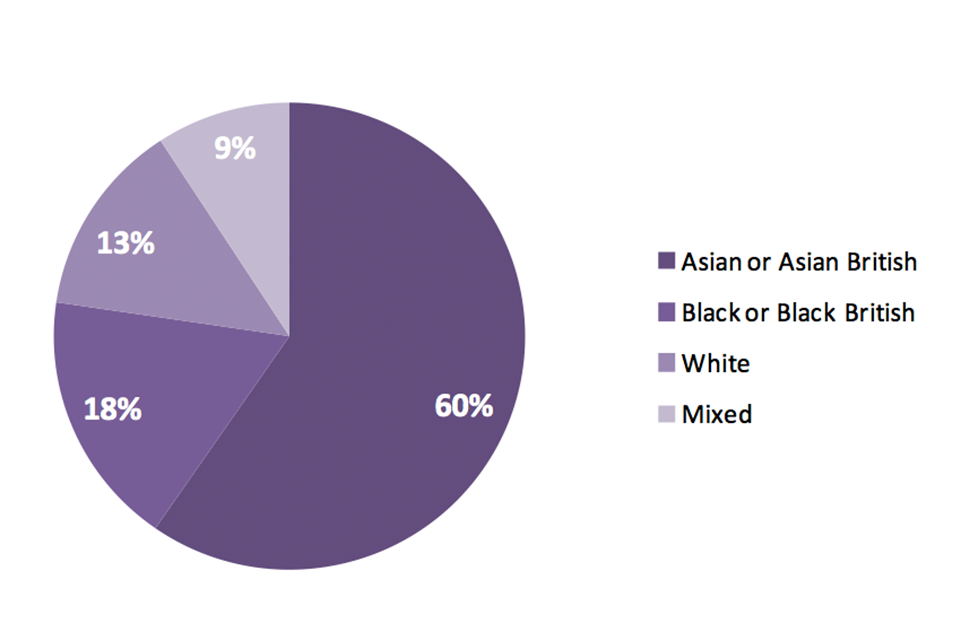
Source: Home Office, Data table P.02.
Chart Notes:
- Does not include persons in custody for domestic extremism.
- Excludes cases where ethnicity was not recorded.
- There was nobody in custody for terrorism-related offences, as at 31 December 2014, whose self-defined ethnicity came under the ‘Chinese or Other’ category.
As at 31 December 2014, of the 59 persons in prison for domestic extremism:
- the majority (31) considered themselves to be Christian, and 22 considered themselves to have no religion
- 96% considered themselves to be of ‘White’ ethnicity (excluding cases where ethnicity was unrecorded)
- 93% considered themselves to be of ‘British’ nationality (excluding cases where nationality was unrecorded)
The nationality of those in custody for terrorism-related offences and domestic extremism was split across at least 19 different countries. In both cases, the majority (82% and 93% respectively) of these were from the United Kingdom. Further details on the ethnicity, nationality and religion of those in custody can be found in tables P.02 to P.04.
Figure 4.3 Terrorist/domestic extremist prisoners released from custody, by length of sentence, year ending 31 December 20141
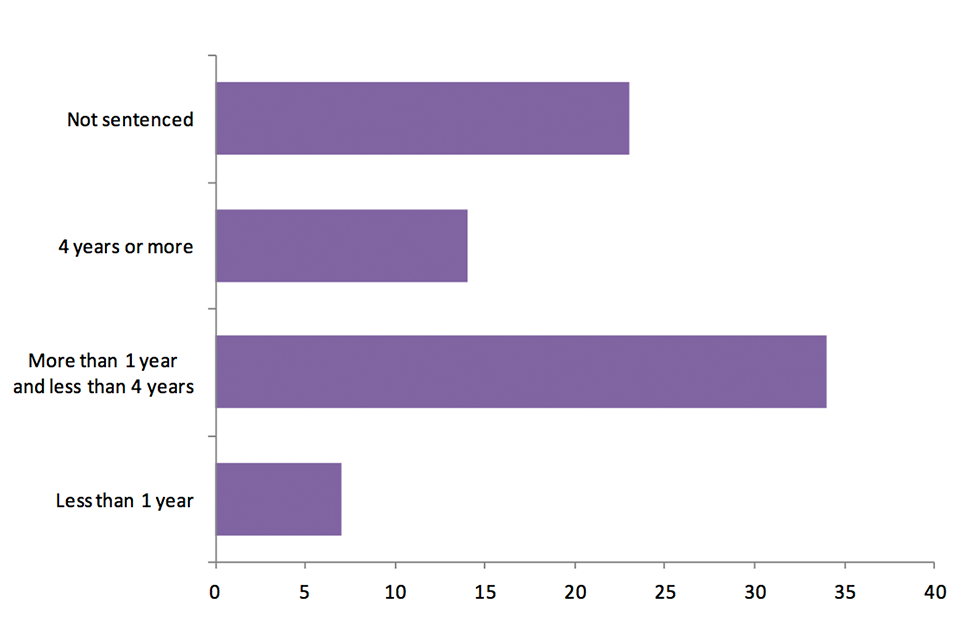
Source: Home Office, Data table P.05.
Chart Notes:
- The ‘not sentenced’ category includes those held in prison custody on remand prior to charge, as well as non-criminal prisoners.
5.2 Data tables
Data to accompany this section can be found in tables P.01 to P.05.
5.3 Data quality and interpreting the figures
Data presented in this section include persons held on remand as well as those held after conviction or sentencing. Categories for types of prisoners are based on assessment at the time of entering custody. Full definitions of these categories can be found in the user guide.
Self-declared religion is given by prisoners on entry to prison. Some prisoners may subsequently change religion. These changes will not be accounted for in the figures. As with all self-declared characteristics, self-declared religion, self-declared ethnicity and self-declared nationality assume that the prisoner has given the correct details. This may not always be the case.
Due to the relatively small numbers of persons in custody for terrorism-related offences, caution is needed when examining the ethnic breakdown of those in custody. Small changes in the number of persons belonging to each ethnic group can lead to large percentage changes.
6. Stops and searches
This section presents statistics on the use of stop and search powers available to the police under TACT 2000. It includes data on the number of section 43 stops and searches, and resultant arrests carried out by the MPS. It also includes data on the number of examinations carried out in Great Britain under Schedule 7 to TACT 2000.
Data on section 43 stops and searches are provided to the Home Office by the MPS. Data on Schedule 7 is provided to the Home Office by the NCTPHQ. This section covers the number of stops and searches, and examinations that were carried out in the most recent 9 quarters to 31 December 2014.
The police have the power to stop and search individuals under section 47A (previously 44) of the Terrorism Act 2000. However, since the legislation was formally amended in 2011, to significantly higher the threshold for authorisation of the power, there have been zero stops and searches under this power. See the [user guide] for more details.
6.1 Stops and searches under the Terrorism Act 2000
Section 43 of TACT 2000 allows a constable to stop and search a person whom he reasonably suspects to be involved in terrorist activity. As many forces are unable to separate s43 TACT stops and searches from other stops and searches, this section includes data from the MPS only and excludes ‘vehicle only’ stops and searches.
In the year ending 31 December 2014, 394 persons were stopped and searched by the MPS under section 43 of TACT 2000. This represents a fall of 20% on the previous year total of 491. The proportion of persons searched under section 43 who were subsequently arrested was 6% in the year ending 31 December 2014, one percentage point lower than the previous year.
Figure 5.1 Stops and searches and resultant arrests under section 43 of the Terrorism Act 20001, Metropolitan Police Service
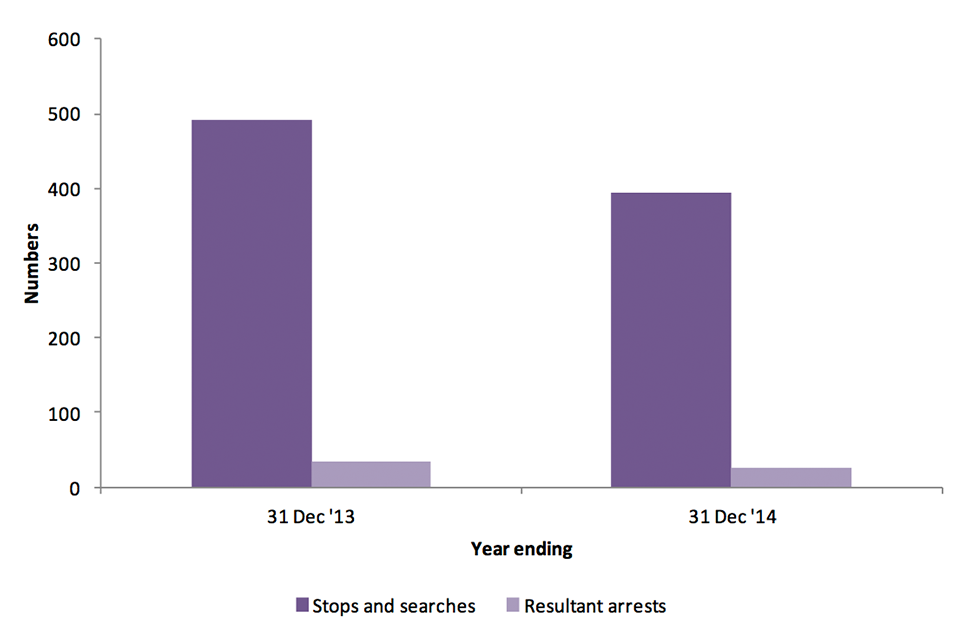
Source: Home Office, data table S.01.
Chart Notes:
- Excludes ‘vehicle only’ searches.
The number of people stopped and searched under section 43 of TACT 2000 fell for every ethnicity between the year ending 31 December 2013 and the year ending 31 December 2014. Most noticeably, stops and searches of those who self-defined as ‘Asian or Asian British’ saw the largest fall, at 45% compared with the previous year.
Those who self-defined as White were subject to the most stops and searches, accounting for 47% of the total (excluding those who did not state their ethnicity). However, this must be considered in line with ethnic breakdowns of both the residential and transient population of the area. According to the 2011 census, 60% of the residential population of London considered themselves to be White. Transient populations are likely to differ from residential populations meaning the ethnic breakdown of those who the police have contact with is likely to differ from the residential population breakdowns.
Although there was a year-on-year fall in the number of stops and searches, this was a result of a relatively low number of searches that were carried out in 2 of the quarters within this period (April to June 2014 and July to September 2014). The most recent quarter saw an increase in the number of section 43 stops and searches carried out by the MPS, reaching its highest level in the reporting period. This is in line with the pattern seen for all terrorism-related arrests, where the most recent quarter is the highest in the reporting period (see section 3).
Figure 5.2 Quarterly breakdown of stops and searches carried out under section 43 of the Terrorism Act 2000, Metropolitan Police Service
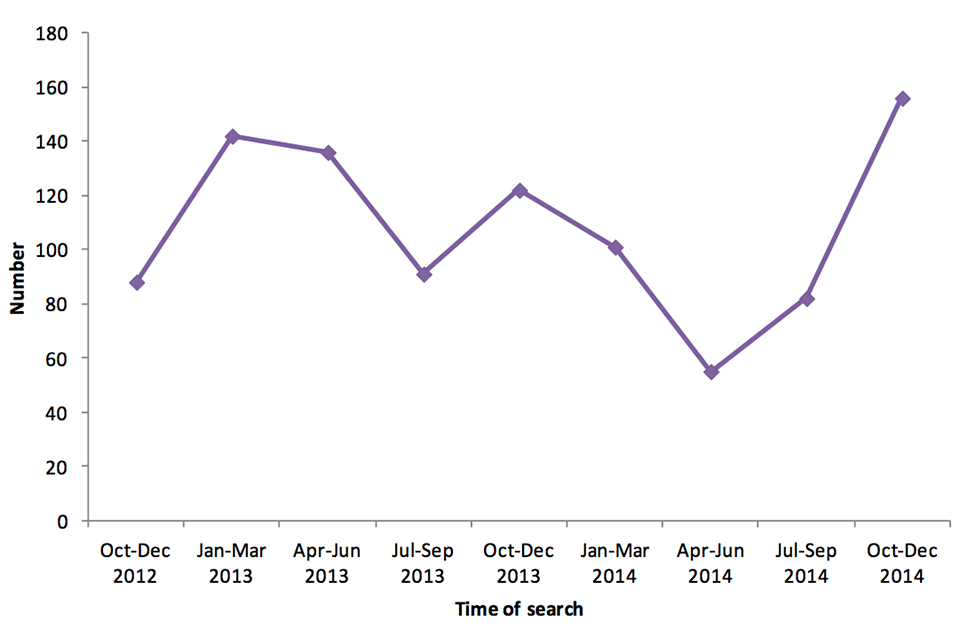
Source: Home Office, Data table S.03.
6.2 Examinations under Schedule 7 to the Terrorism Act 2000
Schedule 7 to TACT 2000 allows an examining officer to stop and question individuals travelling through ports, airports, international rail stations or the border area. When necessary they may also detain and search individuals. The aim is to determine whether that person appears to be someone who is or has been concerned in the commission, preparation or instigation of acts of terrorism.
In the year ending 31 December 2014, a total of 35,004 examinations were conducted under this power in Great Britain, a fall of 24% on the previous year. Throughout the same period, the number of detentions following examinations almost doubled, from 549 in the year ending 31 December 2013 to 1,043 in the year ending 31 December 2014. The fall in the number of examinations could in part be due to site closures across the network and an increase in demand of resources. Furthermore, a more intelligence-led approach to identifying vulnerable travellers and terrorist activity is likely to have led to more focused use of the power resulting in a lower number of examinations. The increase in the number of detentions follows the introduction of the Anti-social Behaviour, Crime and Policing Act 2014 in August 2014, which amended the powers under Schedule 7 to the Terrorism Act 2000 to ensure that a mandatory detention takes place where an examination lasts for more than an hour.
Figure 5.3 Number of Schedule 7 examinations carried out, by length of examinations
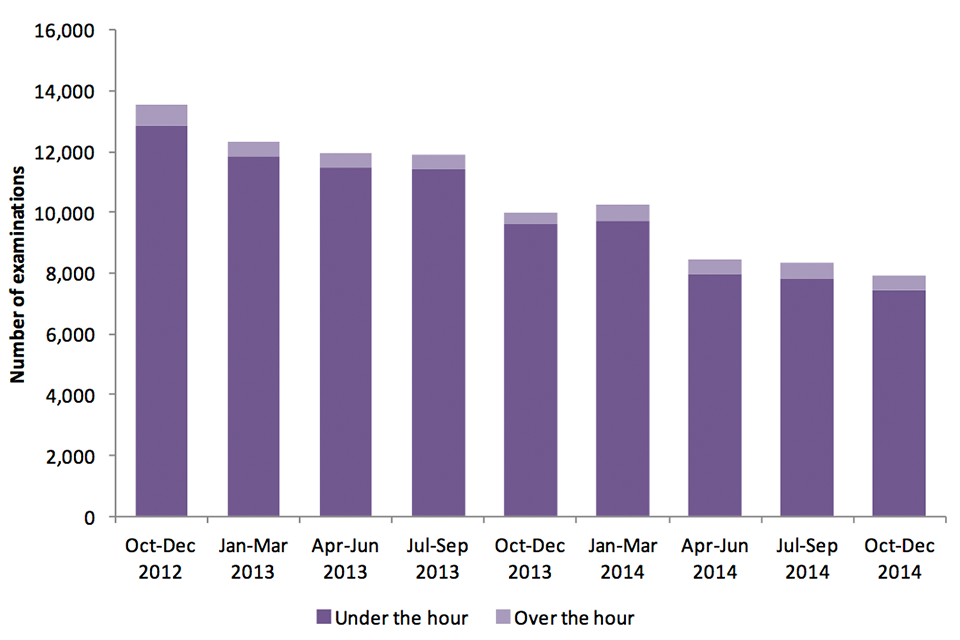
Source: Home Office, Data table S.04.
The fall in the number of examinations fell across all ethnic groups, most notably ‘White’, which saw a 32% fall in the year ending 31 December 2014 compared with the previous year. The increase in the number of detentions was also seen across all ethnic groups, most notably ‘Asian or Asian British’ which more than doubled from 178 detentions to 364.
Excluding those who did not state their ethnicity, the proportion of all examinations accounted for by each ethnic group in the year ending 31 December 2014 has remained fairly similar to the previous year, although some small changes were seen. The proportion of those examined who were considered:
- ‘White’ fell by 5 percentage points (from 45% to 40%)
- ‘Asian or Asian British’ increased by 2 percentage points (from 23% to 25%)
- ‘Chinese or Other’ increased by 2 percentage points (from 18% to 20%)
Full details on Schedule 7 examinations and detentions can be found in tables S.04.
6.3 Data tables
Data to accompany this section can be found in tables S.01 to S.04.
6.4 Data quality and interpreting the figures
Ethnicities of search recipients reported under section 43, 47A and Schedule 7 are self-defined, and therefore may differ from the actual ethnicities of persons searched in a small number of cases. For example, the persons stopped and searched may give a false ethnicity at the time of the search.
The use of stop and search practices are regularly reviewed by the Home Office, HM Inspectorate of Constabulary, and other policing-related bodies, to ensure the practices are used fairly and proportionally. Such reviews can affect the way in which police officers enforce stop and search powers, which will in turn have an impact on the figures in this section.
Due to the relatively small number of persons stopped and searched by the MPS under section 43 of TACT 2000, caution is needed when examining the ethnic breakdown of those arrested as a result of such stops and searches. Small changes in the number of persons belonging to each ethnic group can lead to large percentage changes.
7. Revisions analysis
This section gives some general information about data revisions between releases. Where major changes are made, they are outlined below. There have been no such changes in this release.
7.1 Arrests and outcomes
As data for the section are drawn from a live database, most of the differences between releases are a result of case progression over time. For example, in historic years/quarters the number of persons bailed to return pending further investigation, and those awaiting trial, show small decreases between releases as more investigations and trials are complete. This in turn leads to small increases in the number of persons charged or released without charge, as well as convicted and given other outcomes.
On some occasions changes in classifications of offences can cause more significant changes. However, no such changes occurred for this release.
7.2 Court proceedings
Figures presented in this section are based on completed cases. Therefore revisions are not expected between releases, unless a conviction is quashed as a result of appeal. No sentences have been quashed in recent years and therefore no recent submissions have been made between releases.
7.3 Terrorist and extremist prisoners
Prisoner population figures presented in this release are based on population at specific dates which are not expected to change retrospectively. There have been no recent revisions to this section between releases.
7.4 Stops and searches
Stop and search data are drawn from administrative systems held by the police. Therefore on some occasions revisions may be made, for example where details of a search have been entered into the system and additional details (such as the outcome of the search) subsequently arise. No recent revisions have been made to this section between releases.
8. Consultation
In order to gain a better understanding of the way in which the statistics in this release are used, the Home Office is undertaking a user consultation. The aim of this is to better understand the priorities of those who use the statistics, and which sections of the release are most useful. Two key areas that the consultation seeks feedback on are the importance of timeliness of the statistics, and the usefulness of the commentary published alongside the data.
Currently the Home Office produces three quarterly releases in this series (in the spring, summer and winter) and an annual release (in the autumn). The releases are usually based on the quarter ending around six months before publication.
In order to produce more timely statistics, the level of detail produced in the commentary in each of the quarterly releases could be reduced to include a summary of the key points only. The consultation seeks feedback on the advantages and disadvantages of this approach. It is intended that the annual release will remain unchanged, and will continue to contain the same amount of commentary to aid interpretation of the statistics.
Users are encouraged to have their say by following the link above.
